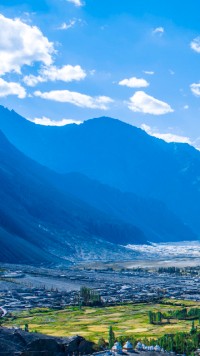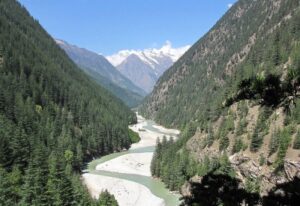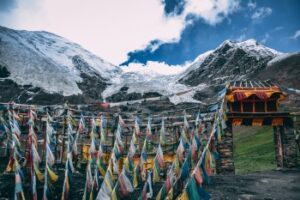
Ladakh
Sunday Discussion Point
 – Kaushal Kishore*
– Kaushal Kishore*
All eyes are fixed on the Third Pole today. The proponents of Greater Nepal, these days headed by the Prime Minister Khadga Prasad Sharma Oli, forged a new map in order to introduce the new emblem of tourism department and to claim certain Indian territories. Reacting to the diplomatic move on it, Chairman of the Nepal Communist Party and twice Prime Minister of Nepal, Pushpa Kamal Dahal “Prachand” seems to provoke Nepal government to launch an offensive against India. Sikkim reacted to an advertisement in Indian Press dealing with a unique mixture of civil and defense, when Delhi government seems to fix them between Bhutan and Nepal. The Indian Army denounced certain rumours in social media dealing with Sino-India border disputes. The fake Himachal Regiment having its headquarter at Kangra, and so called detention of five thousand Indian troops by Chinese are a few of them. These pieces of information are new to a series that turned the Third Pole into the most militarised region of the Holy Planet. The trifurcation of Jammu and Kashmir with creation of Ladakh, after the suspension of Article 370 of Indian Constitution, is already there. This kind of the narratives developed around the Himalayas during the lockdown.

Today the China Town scattered across the globe is a reality. The People’s Liberation Army (PLA) makes several unusual moves on the Line of Actual Control (LAC). Doklam standoff that prolonged for 72 days (June 16, 2017 to August 28, 2017) is not an old memory. The position of two nations on Line of Actual Control (LAC) can reveal the bone of contention. The Sino-India Border is roughly four thousand km long, and India claims position on 3488 km long stretch on LAC and Chinese believe it to be around 2000 km long. The Indian Army deals with 170 cases of transgressions, including 130 in Ladakh, during first four months of the year. The data reveals a marked increase in the number of Chinese transgressions in Ladakh and other regions. There were 663 cases of transgression in 2019 as compared to 404 in 2018. The 75 per cent rise in Western Himalayas and the 55 per cent spike in Eastern Himalayas suggest the failure of working machination for consultation and coordination on Sino-India Border Affairs, which was established in January 2012 after the dialogue between then NSA Shiv Shankar Menon and his Chinese counterpart Dai Bingguo. Actually this forum is headed by joint secretary-level bureaucrats from both sides. Prime Minister Modi and President Xi met at Bishkek, Wuhan and Mahabalipuram to address these issues. It needs adequate attention for better functioning and to ensure the peaceful settlements of border disputes.

Recently China amassed troops on their side of the LAC, no matter whether Harsil Valley in Uttarakhand or Galwan Valley in Ladakh. As a consequence, Indian Army has been increasing its presence in border states like Uttarakhand, Arunachal Pradesh, Sikkim and Ladakh. It seems that the Himalayan atmosphere is charged like never before in the history. The three monologues further predict the fate of the Third Pole as the battleground of a new Mahabharata. PM Modi addressed heads of armed forces directing them not to stop the road construction, making it clear that India would not be scaling down its deployment in the face of aggressive military posturing by the neighbour. The Chairman of Everything in China addressed National People’s Congress and the PLA annual meeting, where clearly ordered the military to think about worst-case scenarios, promptly scale up training and battle preparedness, and effectively deal with all sorts of complex issues that includes resolutely safeguarding national sovereignty, security and the other development interests. Meanwhile, India got chairmanship of the executive board of World Health Organisation. Next day the US President Donald Trump offered to mediate or arbitrate the border disputes. As a cordial gesture it could have been better to extend the solidarity with India while suggesting for bilateral negotiations at this juncture. The situation on ground is unusually tense with seasonal fire in the forest and the spike in poaching it’s all the more deplorable during the COVID-19 pandemic.

The trijunction of India, China and Nepal on ancient Kailash-Mansarovar footpath is located in Lipulekh Region of the Himalayas. Since the rift between the two senior most comrades—Oli and Prachand—reached at its peak domestic politics in Nepal is in an ugly shape. A new exercise for the enrichment of new found democracy or the outcome of a desire to the hot seat is in feature. The ghost of unrest that started with the promulgation of new constitution, almost five years ago, still hunts the Himalayan nation-state. The Madhesh Movement and blockade on Indo-Nepal border are in the backyard. The coalition government of communist parties in Nepal and its evolution for the definition of a secular kind of nationalism is against India in recent times. The chief of Indian Army referred to it while talking about Lipulekh to fuel the fire. I think we need to thank Nepal to raise it a couple of decades ago with the advent of the Karakoram Highway (G219), and again in 2015, when India and China agreed to construct a highway on the trade route between the two nations and to redefine pilgrimage to the ancient shrine. The Hindu pilgrims can never forget the services rendered by Nepal and its people during the pilgrimage. The recent controversy started since Defense Minister Rajnath Singh inaugurated the 80 km long Link Road in Uttarakhand connecting the trijunction via video conferencing on Friday, 8th May. After that Kathmandu published five thousand maps to be displayed across the Himalayan destinations. The landlocked Nepal has been trying hard to build better transportation infrastructure connecting to the port at Bay of Bengal. The diplomatic channels now look into it, and this ray of hope depends on peaceful negotiations.
Also read: The crisis of reverse migration
The institutions of civil service and defense service are two different orders of the civilised world. The two sometimes stand against each other, no? The government is trying to club the two as civil-defense-corps. It reminds an old adage that the two opposite poles attract each other. The Delhi government has issued a recruitment for volunteers in an advertisement that dilutes the position of Sikkim, the 22nd province of Indian union since 15th May 1975. Arvind Kejriwal government takes it back promptly. The LG has suspended Rahul Sudan, the civil servant responsible for releasing it with immediate effect for this disrespect of territorial integrity of India. This case revealed the failure of rule books that seldom failed to keep the promises contained in 36th and 37th amendments of the Constitution. The healing of wounds and this process of rectification are not entirely disconnected affairs.

Tibet and Taiwan are significant factors defining Sino-India relations for decades. The United Nations has replaced ROC with ROC in 1971 to reaffirm the story of two kinds of China. The definitions of these two acronyms—ROC (Republic of China or Taiwan) and PRC (People’s Republic of China)—bear different geo-political significances. Recently, the Chinese embassy in India retorted when a couple of lawmakers from India participated in oath ceremony of the re-elected President of Taiwan via video conferencing. If Meenakshi Lekhi wished Tsai Ing-wen on her re-election, what’s objectionable in it? Tibet is as an autonomous region within the PRC, however, its government in exile runs from Dharamshala in India. New Delhi keeps the distance with the government in exile, but its presence in India since 1959 is one of the causes of ire in Beijing’s eyes. Today the communist parties are in power in Taiwan and Vietnam, and their relationship with China is unbearable. The two countries are being noticed for better management of the pandemic with least infection and casualty. Recently, WHO has invited Taiwan to aid and assist the investigation dealing with Biological Weapon Theory against China.  The annual report of National People’s Congress has mentioned about the reunification with Taiwan. But this time the term ‘peaceful reunification’ lacks the adjective. People’s Liberation Army Senior Colonel Wu Qian, the Defense Ministry spokesperson of China has defined it that Taiwan independence is a dead end. The series of protests in Hong Kong is yet another geopolitical affairs that China invited us to comment after the Ladakh issue. In this scenario dragon’s infallibility is at stake. It’s a call for better cooperation and coordination in order to restore peace in the region.
The annual report of National People’s Congress has mentioned about the reunification with Taiwan. But this time the term ‘peaceful reunification’ lacks the adjective. People’s Liberation Army Senior Colonel Wu Qian, the Defense Ministry spokesperson of China has defined it that Taiwan independence is a dead end. The series of protests in Hong Kong is yet another geopolitical affairs that China invited us to comment after the Ladakh issue. In this scenario dragon’s infallibility is at stake. It’s a call for better cooperation and coordination in order to restore peace in the region.
Apart from the poles, the Himalayas is largest accumulation of snow, the life giving force in crystalized form. As such the cold intellectuals referred to it as the Third Pole. But this cold region no longer remains so with heavy deployment of security forces and weapons of destruction. Rise of transport projects in this region is closely linked to the Sino-India War in 1962. Border disputes on banks of Pangong Tso (Pangong Lake) started during Operation Vijay, when the Indian Army from the area was moved to Kargil in 1999. China took the opportunity to build 5 km long road inside Indian territory along the bank. This is an addition to the extensive network of roads built by Chinese, which connects with Karakoram Highway. This is an ambitious project connecting China and Pakistan, and is also a little part of the greater initiative that encompasses through Asia, Africa and Europe on ancient Silk Route. These projects deliberately created ecological imbalance in the Himalayas and militarised the peaceful region massively. Today the Third Pole seems all prepared (?) to be the battlefield for the war that Chinese leadership has recently referred to. He has also mentioned China as largest democracy committed to the public wellbeing. It reminds us what President Xi Jinping and Prime Minister Narendra Modi have promised a couple of years ago at Wuhan while committing to the innovative and sustainable solutions to global challenges like epidemics, natural disasters, climate change and terrorism. If trans -Himalayan nations failed to go ahead and flourish on the track of democracy, dialogue and prosperity they are bound to perish together.
*Kaushal Kishore is a member of All India Panchayat Parishad from Bihar. The writer is the author of The Holy Ganga (Rupa, 2008), Managing Editor of Panchayat Sandesh. His column, Across The Lines, appears in vernacular publications. The published article is his own views.





